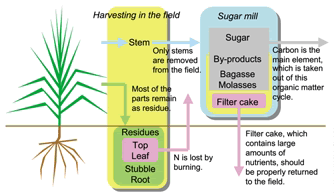Sustainability of sugarcane production evaluated based on N2 fixation and organic matter cycle
Description
[Objectives]
In Northeast Thailand, infertile sandy soil with limited ability to supply and retain nutrients is distributed over large areas. Crops with the ability to fix atmospheric nitrogen endophytically could contribute toward the establishment of sustainable agriculture in these areas, and taking this into consideration, analyses on N2 fixation in sugarcane and the organic matter cycle of sugarcane production were conducted to evaluate their sustainability.
[Results]
Possible N input by N2 fixation in sugarcane planted in the research fileds was estimated by the natural 15N abundance (δ15N) method using cassava as a presumed non-N2-fixing reference plant. All seven varieties of sugarcane planted in the fields of the research centers showed clearly lower (δ15N) values than those of cassava. Average of N input by N2 fixation in the seven sugarcane varieties was 29% (Fig. 1).
Possible N input by N2 fixation in field-grown sugarcane was also estimated by the natural 15N abundance(δ15N) method using neighboring weeds growing inside the sugarcane fields as presumed non-N2-fixing reference plants. Of the total of 54 sugarcane samples, (δ15N) values of 19 samples were markedly lower than those of all neighboring plants. Average contribution of N2 fixation to total plant N of these 19 sugarcane samples was estimated to be 32% (Table 1).
In order to determine the organic matter cycle of sugarcane production, only the stems were removed from the field and most of the other parts remained as residues. Thus, most of the nutrients contained in the residues were returned to the field. In the process of sugar refining at sugar mills, bagasse, filter cake and molasses are discharged as by-products. The main element of the sugar, bagasse and molasses taken out of this organic matter cycle is carbon, on the other hand, filter cake contains large amounts of nutrients. In order to maintain a sustainable cycle of nutrients, the leaves of sugarcane should not be burned during harvesting and filter cake should be properly returned to the field (Fig. 2).
Figure, table
-
Fig. 1. Estimation of N2 fixation in different varieties of sugarcane planted in research fields based on the natural 15N abundance method. -
Table 1. Estimation of N2 fixation in field-grown sugarcane in Thailand.
aNumber of samples with δ15N values lower than those of all neighboring plants.
bEstimated % nitrogen derived from N2 fixation. -
Fig. 2. Organic matter cycle of sugarcane production.
- Affiliation
-
Japan International Research Center for Agricultural Sciences Crop Production and Environment Division
-
Department of Agriculture Thailand
NARO Agricultural Research Center
- Classification
-
Technical A
- Term of research
-
FY2001 (FY1997-2001)
- Responsible researcher
-
ANDO Shotaro ( Crop Production and Environment Division )
MATSUMOTO Naruo ( Crop Production and Environment Division )
MEUNCHANG Sompong ( Department of Agriculture Thailand )
PRASERSAK Praphan ( Department of Agriculture Thailand )
THIPPAYARUGS Srisuda ( Department of Agriculture Thailand )
OHWAKI Yoshinari ( NARO Agricultural Research Center )
- ほか
- Publication, etc.
-
S. Ando, S. Meunchang, S. Thippayarugs, P. Prasertsak, N. Matsumoto and T. Yoneyama (2002): Sustainability of sugarcane production evaluated based on organic matter cycle and nitrogen fixation. Proceedings of the 17th World Congress of Soil Science, Paper No. 1948, 1-8.
- Japanese PDF
-
2001_08_A3_ja.pdf497.32 KB
- English PDF
-
2001_07_A4_en.pdf87.24 KB



